组织工程种子细胞的质量和数量是组织工程组织应用于临床的重要因素。人脐带间充质干细胞作为一种新型的种子来源,如何快速获得大量的细胞,并保证有效的质量,需要从体外培养的影响因素入手,确定适宜的培养条件和参数。
细胞培养基一般以葡萄糖为碳源,氨基酸为氮源,并添加维生素等细胞生长必需成分。细胞代谢葡萄糖产生乳酸或丙酮酸和二氧化碳,代谢谷氨酰胺产生丙氨酸和氨。乳酸和氨除了自身浓度对细胞的浓度依赖型毒害外,还影响pH值,从而影响细胞代谢的酶活力,最终影响细胞生长
[5-6]。控制培养系统中营养物质及代谢产物的方法是采用灌流培养工艺,通过不断的补充新鲜培养基,排出代谢产物,控制有害代谢产物的积累。间充质干细胞体外培养的生长曲线包括延迟期、对数生长期和生长稳定期。由于间充质干细胞是贴壁细胞,所以单层培养条件下,当细胞长满单层培养的有限空间时,细胞生长因接触抑制、生长空间缺乏而缓慢或者停止,然后胞外基质分泌增强,表现在随着培养的进行,尤其培养后期,胰酶消化后有较多粘膜出现。间充质干细胞体外培养条件和参数对细胞的扩增、生长、分化、表面抗原特性有着重要影响
[7]。
文章通过考察半连续灌注培养(或换液培养)的培养参数对细胞生长代谢的影响,得出:人脐带间充质干细胞在生长延迟期(约48 h)内消耗葡萄糖和谷氨酰胺等营养物质,自我合成和分泌一些后续生长所需的营养因子和生长因子,过早的灌注会造成这些生长所需因子的丢失,延长生长延迟期,进而影响后续生长。48 h时细胞已经完全适应培养环境,此时的培养液中葡萄糖和谷氨酰胺充足,乳酸和氨浓度均低于1 mmol/L,而且自分泌的因子较充足,是启动灌注的适宜时间。文献报道,5 mmol/L的乳酸浓度对间充质干细胞生长影响不大
[5]。段小军等
[8]通过研究种植密度、首次换液时间对人骨髓间充质干细胞原代培养时间的影响,得出原代培养的适宜培养条件为(1-3)×10
5/cm
2细胞密度、48 h换液。李德华等
[9]观察换液频率对人脐静脉间充质干细胞增殖生长的影响,得出启动时间为24 h、频率为每天的换液培养条件下,细胞增殖最快,生长状态最好,但培养14 d后达到的细胞密度相同。
实验中灌注频率和灌注体积越大,获得的细胞密度越大,最大细胞密度为18.52×10
4 /cm
2,比接种密度提高了73倍,是批培养的1.5倍;对数生长期的比生长速率在0.5-0.6 d
-1范围内,倍增时间为25-30 h。灌注频率和灌注体积越大,葡萄糖供给越充足,乳酸浓度越低,葡萄糖比消耗速率和乳酸比生成速率也越高, 乳酸对葡萄糖的代谢系数越大,说明在较高的灌注频率和体积下,葡萄糖充足,使得葡萄糖较多地生成乳酸,葡萄糖的利用率有所降低。类似地,灌注频率和灌注体积越大,谷氨酰胺供给充足,氨浓度越低,谷氨酰胺比消耗速率越低,氨比生成速率越高,氨对谷氨酰胺的代谢系数越大,说明除了谷氨酰胺之外,其他氨基酸的消耗增大,提高了氨的生成。在静态单层培养条件下,由于贴壁面积的有限性,造成人脐带间充质干细胞的生长空间有限。另外人脐带间充质干细胞的传代次数有限,当单层培养的细胞贴满后产生接触抑制,会停止生长,进行胞外基质的分泌。较大的灌注频率和体积下,不仅葡萄糖和谷氨酰胺充足,而且细胞所需的微量元素和未知的因子也充足,满足了细胞生长的要求;同时排除乳酸和氨等对细胞的不良影响,使得细胞处于较新鲜的培养液中,及时去除条件培养基中某些因子对细胞的交互影响,减缓了胞外基质的分泌,提高了细胞的扩增。因此,静态半连续灌注培养条件下扩增人脐带间充质干细胞的适宜条件是批培养48 h启动灌注,每天更换培养液体积的75%。
灌注培养中细胞和营养物质的物料衡算公式如(1) -(2)。
.jpg)
其中,Xv为活细胞密度(10
9 L
-1);t,培养时间(d);μ,比生长速率(d
-1);D,稀释率(d
-1);f,细胞流失率,无因次,介于0-1之间;1-f,细胞截留效率,无因次;S,培养液中营养物质浓度。(mmol/L);S
f,补加液中营养物质浓度,mmol/L;q
s,营养物质比消耗速率[mmol/(10
9 cells·d)]。实验条件下根据公式(1)和(2)得出的计算结果,见表5。
.jpg)
实验在静态单层条件下进行,细胞一旦贴壁,就不会脱落,可以实现细胞的100%截留,即f=0,加上细胞没有死亡,因此公式(1)变为
.jpg)
,细胞呈指数生长,此时稀释率大小不会影响细胞生长,只要补加营养物质充足,贴壁空间存在,细胞会无限制生长。实验中营养物质充足,细胞最终长满整个单层贴壁空间,因接触抑制而停止生长。以葡萄糖为例,由于细胞不断生长,所以葡萄糖不断被消耗,没有达到平衡。在这种情况下,若贴壁空间无限,细胞最终会因为营养物质缺乏而停止生长。
然而在动态培养条件下,比如微载体搅拌培养,细胞不可能完全截留,而且细胞在搅拌下会有部分脱离微载体,进入培养液呈悬浮状态,进而重新贴壁、死亡或者随培养液丢弃,所以0<f<1,使得在补加培养成分浓度已定条件下细胞密度最终达到稳定,不会无限制生长,此时达到细胞和营养物质在内的系统的稳定。
对于脐带间充质干细胞在生物反应器中的三维微载体培养,如果不断加入新鲜微载体,提供细胞贴附的面积,同时以一定比例取出细胞贴附的微载体,就会不断获得细胞,并且由于培养条件恒定,提供的细胞质量也均一,从而在质量和数量上满足临床应用的要求。
基金资助:中国博士后基金面上项目资助(2011M500780)。
作者贡献:实验设计、实施、资料收集和成文由第一作者完成,实验评估由全部作者完成,第二、三作者审校并对文章负责。
利益冲突:课题未涉及任何厂家及相关雇主或其他经济组织直接或间接的经济或利益的赞助。
伦理要求:由江苏省干细胞工程技术研究中心提供健康产妇正常足月新生儿脐带,产妇和家属同意用于科学研究。
作者声明:文章为原创作品,数据准确,内容不涉及泄密,无一稿两投,无抄袭,无内容剽窃,无作者署名争议,无与他人课题以及专利技术的争执,内容真实,文责自负。
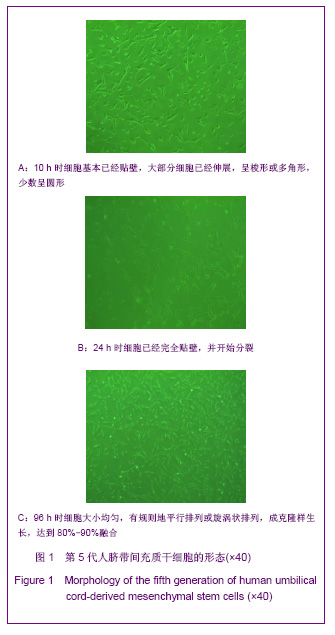
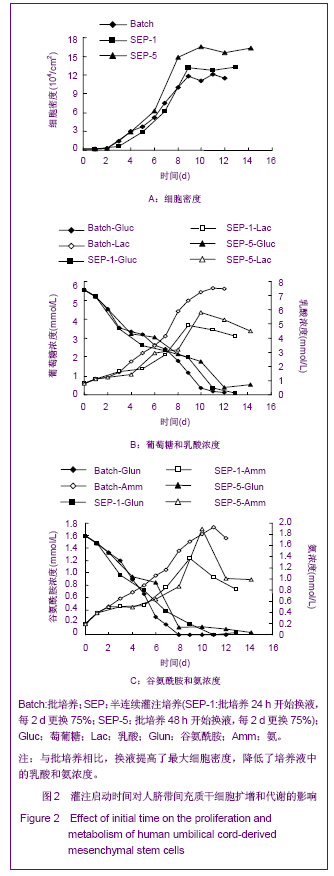
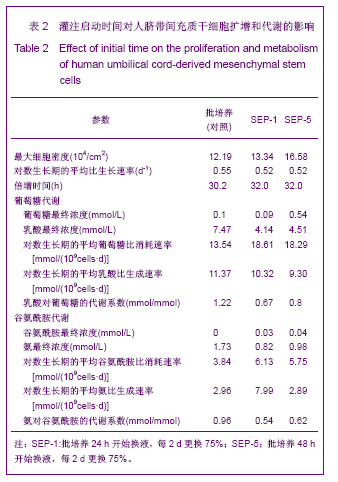
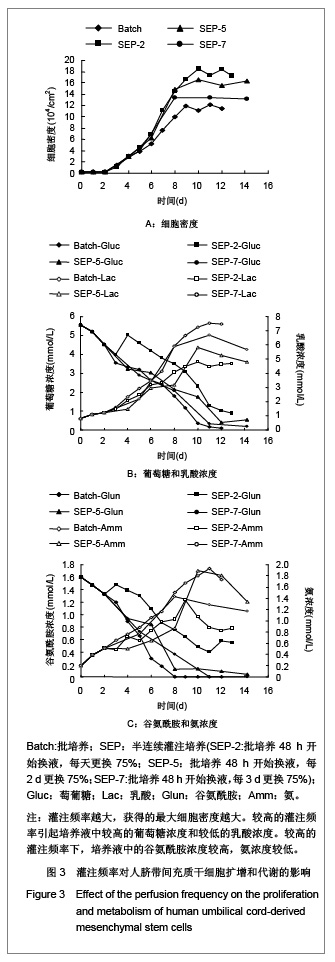
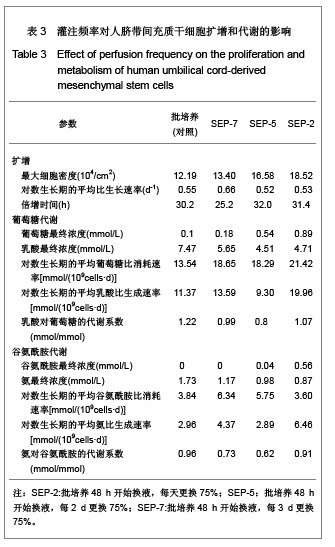
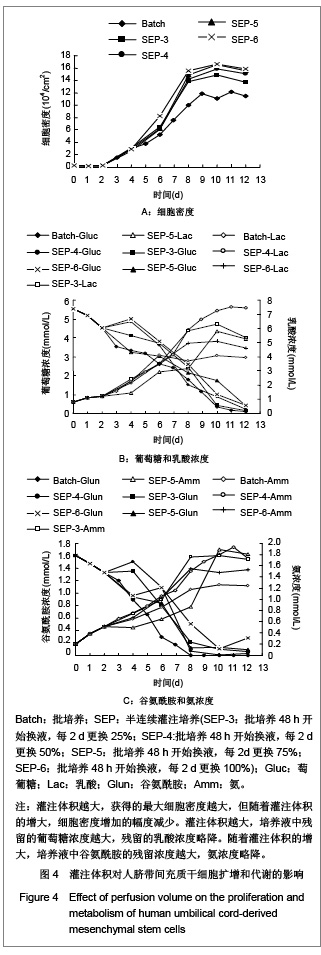
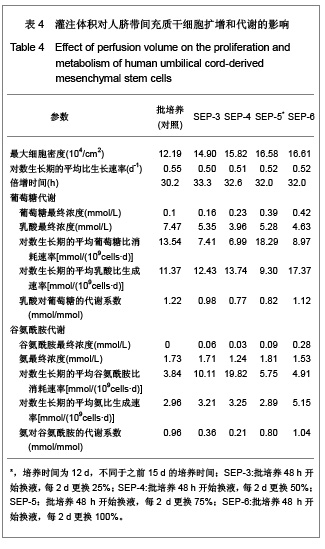

.jpg)
.jpg)